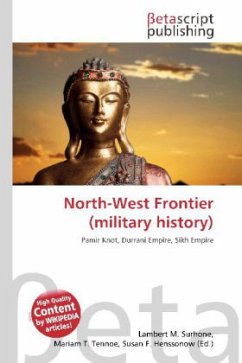
North-West Frontier (military history)
Versandkostenfrei!
Versandfertig in 6-10 Tagen
32,99 €
inkl. MwSt.

PAYBACK Punkte
16 °P sammeln!
Please note that the content of this book primarily consists of articles available from Wikipedia or other free sources online. The North-West Frontier of the Indian sub-continent extends from the Pamir Knot in the north to the Koh-i-Malik Siah in the west, separating Pakistan''s North-West Frontier and Baluchistan Provinces from Afghanistan. In doing so it divides the Pakhtun inhabitants of these provinces from their kinsmen in Afghanistan. Much of the Frontier was won by Ranjit Singh in the early 19th century, and then taken over by the British East India Company when it annexed the Punjab i...
Please note that the content of this book primarily consists of articles available from Wikipedia or other free sources online. The North-West Frontier of the Indian sub-continent extends from the Pamir Knot in the north to the Koh-i-Malik Siah in the west, separating Pakistan''s North-West Frontier and Baluchistan Provinces from Afghanistan. In doing so it divides the Pakhtun inhabitants of these provinces from their kinsmen in Afghanistan. Much of the Frontier was won by Ranjit Singh in the early 19th century, and then taken over by the British East India Company when it annexed the Punjab in 1849. The two main gateways on the Frontier are the Khyber and Bolan Passes. Since ancient times India has been invaded by these routes. With the expansion of the Russian Empire into Central Asia, stability of the Frontier and control of Afghanistan became cornerstones of defensive strategy for British India. Between 1849 and 1947 the military history of the frontier has been a succession of punitive expeditions against offending Pakhtun (or Pathan) tribes, punctuated by three wars against Afghanistan. Many British officers who went on to distinguished command in World War I and World War II learnt their soldiering on the North-West Frontier, which they called the Grim.












